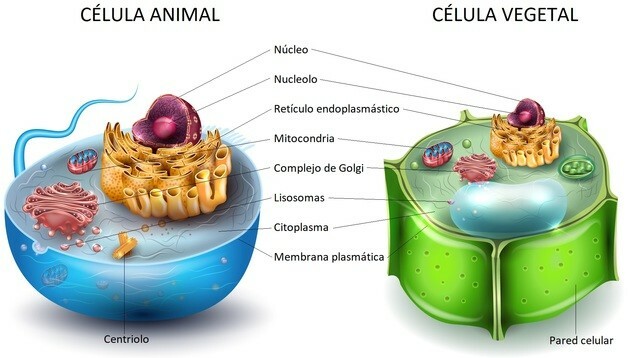Difference between animal and plant cell
The animal cells are those found in animals and vegetables cells they are what we can find in plants and algae.
Both cells are classified as eukaryotes, since they present a defined nucleus where the genetic material is stored. In addition, there are a plasma membrane, membranous organelles such as mitochondria and endoplasmic reticulum, cytoplasm and cytoskeleton.

The main difference between animal and plant cells is the presence of a cell wall and chloroplasts in the plant cell. The following table summarizes the differences between these cells:
| Animal cell | Plant cell | |
|---|---|---|
| Cellular wall | Absent. | Present. |
| Nutrition | Heterotrophic. | Autotroph. |
| Vacuoles | Small: they have one or more. | A large central vacuole. |
| Centrioles | Present | Absent. |
| Chloroplasts | Missing. | Present |
| Plasma membrane | Present. Contains cholesterol. | Present. It does not contain cholesterol. |
| Energy storage | Glycogen | Starch. |
| Plasmodesmata | Absent. | Present. |
| Glioxisomes | Absent. | Present. |
What is an animal cell?
The animal cell is a eukaryotic cell characterized by the presence of a nucleus, plasma membrane, and cytoplasm. It differs from the plant cell by the absence of a cell wall and chloroplasts. In addition, smaller and more abundant vacuoles can be found compared to those of a plant cell.
Animal cells can take various forms. They are also capable of capturing and digesting other structures.
Some of the most prominent animal cells are neurons of the nervous system, leukocytes of the immune system, ova and sperm of the reproductive system.
Characteristics of the animal cell
Nutrition
The nutrition of animal cells is heterotrophic, which means that they need to obtain nutrients and energy from the organic material of other living things.
Energy
The mitochondria It is responsible for generating energy in the animal cell, through the process of cellular respiration. In this process ATP is produced from glucose.
Mitochondria are equivalent to the chloroplasts present in plant cells, since both are responsible for producing energy.
Vacuoles
Vacuoles resemble sacks of water. In animal cells they are usually very numerous and small. Its function is to store water, ions and intracellular waste.
Cytokinesis
Cytokinesis is the division of the cytoplasm during cell division (mitosis or meiosis). In animal cells it is produced through a ring of actin filaments, which squeezes the plasma membrane in half, separating two new cells.
Lysosomes and Centrosomes
Animal cells possess lysosomes, membranous organelles that are responsible for intracellular digestion. They also have centrosomes, which are cylindrical structures involved in animal cell division, which are not found in plant cells.
See also Eukaryotic and prokaryotic cells.
What is a plant cell?
The plant cell is a eukaryotic cell characterized by the presence of a cellular wall that gives you support and protection, while allowing cellular communication. This wall can be found in other types of eukaryotic cells.
Like the animal cell, it has a differentiated nucleus, membrane, and cytoplasm.
However, the plant cell contains unique parts that are responsible for the process of photosynthesis. Something fundamental, since it allows plants to release the oxygen that living beings need to exist.
Characteristics of the plant cell
Nutrition
Plant cell nutrition is autotrophic, so they are able to synthesize all the nutrients they need from inorganic material. That is, they are independent of other living beings to obtain their nutrients.
Energy
The chloroplasts present in plant cells are responsible for carrying out the process of photosynthesis, where sunlight is used as a source of energy. This is possible with the help of chlorophyll, a substance present inside chloroplasts that absorbs sunlight.
These chloroplasts are located next to the membrane and are approximately five microns in size.
Cellular wall
The most outstanding characteristic of plant cells is a cellular wall surrounding the plasma membrane. This wall is composed mainly of cellulose and can measure between 0.1 to 10 microns.
The cell wall provides protection, stability and rigidity to the plant cell.
Vacuoles
Plant cells present a single large vacuole which can cover up to 90% of the cell.
Its function is to store water and maintain the turgor of the cell. When the vacuole is empty, the plant withers and loses rigidity.
Cytokinesis
In plant cells, after the division of the nucleus, an accumulation of vesicles of the Golgi apparatus occurs. These vesicles fuse and give rise to a new cell wall between the two cells.
Plasmodesmata and glyoxysomes
Plasmodesmates are found in plant cells, which are pores in the cell wall that allow molecules to pass between plant cells.
Glyoxysomes are organelles found only in plant cells. Lipids are stored and degraded in these structures, mainly in germinating seeds.
You may also be interested in seeing:
- Eukaryotic cell and prokaryotic cell
- Cell types
- Mitosis and meiosis
- Active and passive cellular transport

Doctor in Biochemistry from the Venezuelan Institute of Scientific Research (IVIC), with a degree in Bioanalysis from the Central University of Venezuela.



